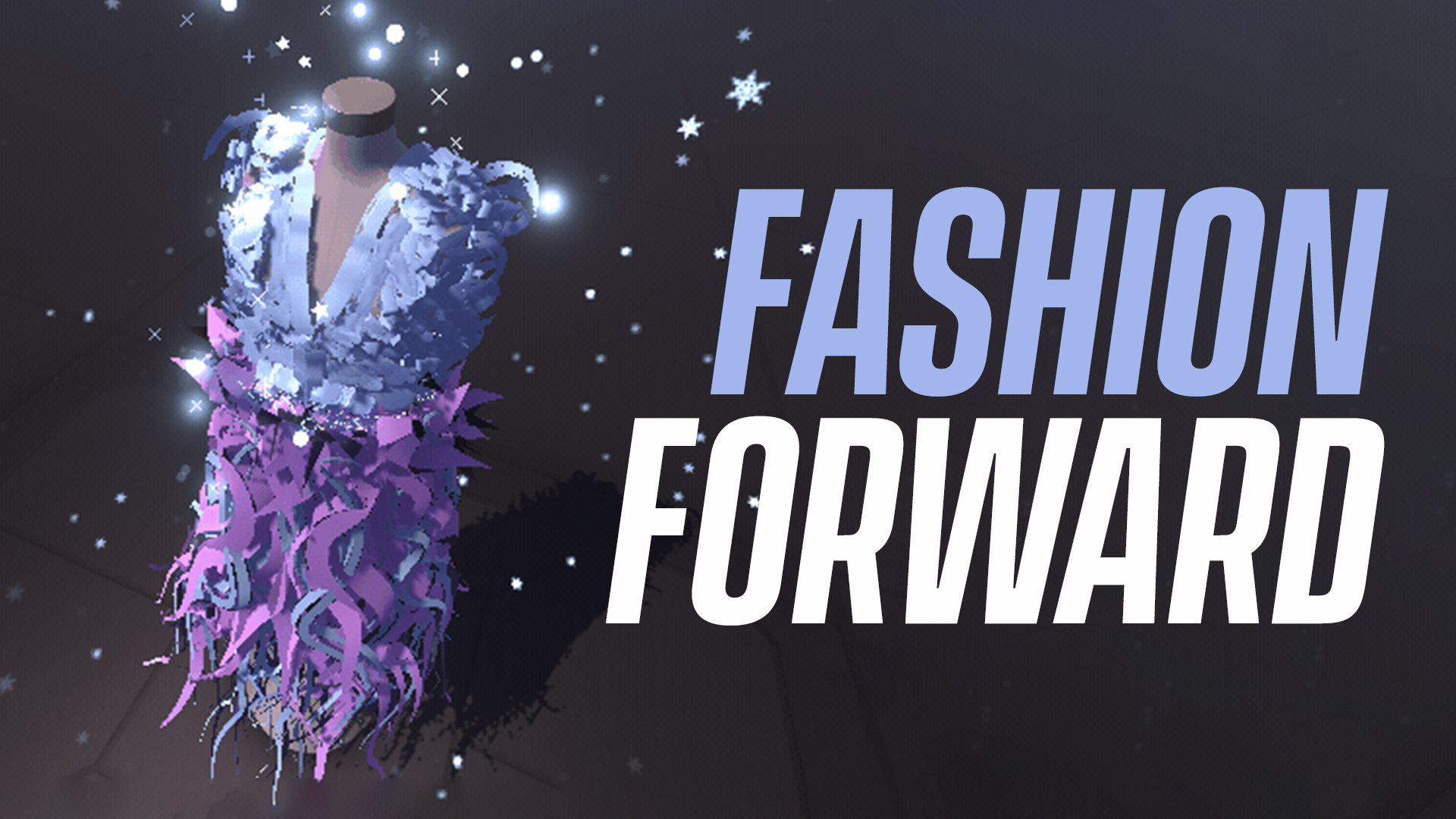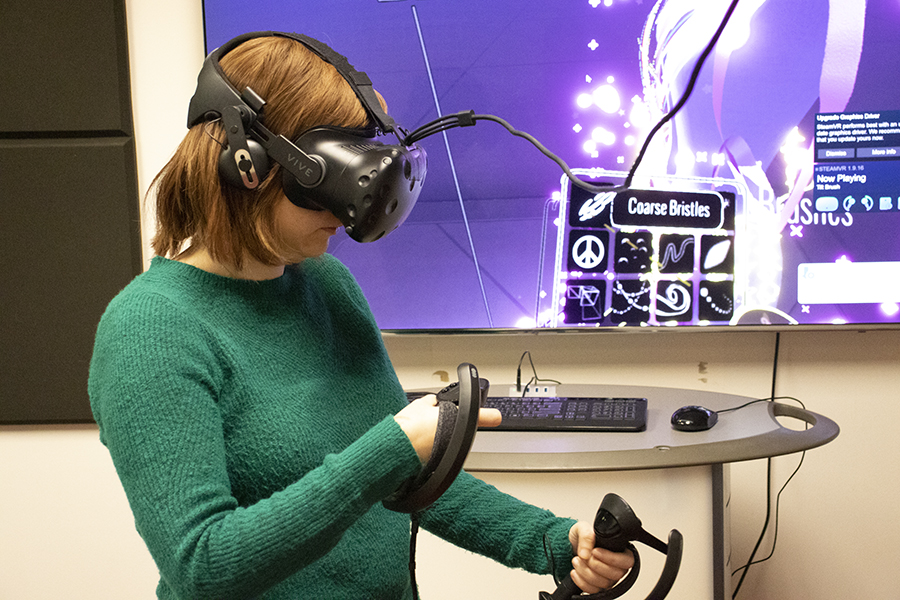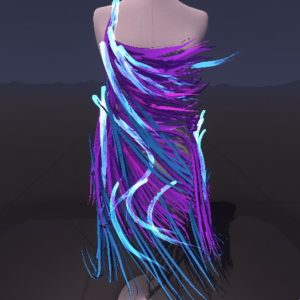
Using virtual reality, students created outfits on dress forms to get firsthand experience with the technology. Pictured here is the outfit created by Julie D’Agostino.
Fashion Forward: Using Virtual Reality in the Apparel World
By Allison Ebner
Shopping online for clothes is convenient. We have access to more styles, more sizes and more variety that can be delivered to our doors at the click of a button. But how many times have we returned something because it wasn’t what we thought it would be from the picture or it didn’t fit how we wanted it to?
Instead of going to your usual online store, imagine putting on a virtual reality headset and being transported to a 3D simulation of that same store. Through this VR simulation, we can walk through the store and pick things up. We can turn a shirt around to get a better sense of how it drapes instead of relying on a 2D picture. In fact, paired with the right technology, VR even makes it possible to try on clothing and see how it specifically works for our body.
Creating an immersive and interactive shopping experience like this is just one of the many ways the fashion industry is already using innovative technology like VR.
As the industry continues to embrace advanced technologies, Professor Katya Roelse, an instructor in the Department of Fashion and Apparel Studies at UD, knows how important it is for her students to have experience with these technologies as they prepare for their careers.

Librarian Amanda McCollom demonstrates the use of the Tilt Brush application in the VR Studio.
In the fall of 2018, Professor Roelse redesigned the course Fashion 380: Advanced Apparel Product Development, incorporating more technology and hands-on experiences to ensure her students have the skills and experiences to keep up with the industry.
“One of the things I wanted to do was share with the students all the different things that are happening in the industry that they could come across,” she said. “There’s virtual reality, body scanning, a lot of data analytics and machine learning. So I had a whole chapter on exposing the students to that.”
As part of that chapter, the class visited the VR Studio in Morris Library’s Student Multimedia Design Center to complete an assignment. The students were directed to play with and imagine the possibilities afforded by VR.
Using the VR application Tilt Brush, the students created an outfit on a dress form. Librarian Amanda McCollom showed the class how to use Tilt Brush—how to move within the space, how to select different textures and colors for their outfit, and how to make a GIF of their design to share.

Students created animated GIFs of their dress form designs. Pictured here is the design made by Thomas Brant.
Several students had never experienced VR before. “I had heard of VR before but had no clue I had access to this type of technology on campus,” Savannah Singer said. “The [librarian] doing the demo made it look so easy and effortless, and I was thinking there is no way I will be able to do this. I thought it was such an amazing technology and way easier to do than I originally thought.”
Other students had used VR to play games. “I had experienced VR at The Void [an immersive virtual reality entertainment venue],” Natalie Kaucic said. “It was truly one of the most incredible experiences I’ve had with technology.”
“… The [VR Studio] demo seemed very similar to what I had experienced at The Void,” she continued. Even though she was familiar with the technology, she hadn’t previously considered that it could somehow be applied to fashion. “It made me excited about the potential future of VR and apparel.”
As part of the assignment, the class had to consider how they saw VR being used in the future of apparel. From design to production, from marketing to historic preservation, students shared a wide range of ideas that captured the breadth of possibilities.
Retailers could create in-store experiences that combine creative storytelling and transparency. While in the store, visitors could put on VR headsets and walk through the production factory, following along as the item is made.

Students designed outfits on 3D dress forms using the Tilt Brush virtual reality application. Picture here is the work of Savannah Singer.
Apparel with historical significance or on view in exhibitions could be captured using VR technology. With these accurate representations of the apparel, historians, designers and industry professionals would be able to interact with these materials to conduct research, look at past trends or get inspired for the future.
VR could also open doors for increased sustainability initiatives. As the students learned in their assignment, it’s easy to adjust designs when they make a mistake. It’s also easier to notice potential issues with design and fit earlier in the process given the 3D nature of VR and the ability to view it from all angles. Using VR could allow for such issues to be fixed pre-production, resulting in less samples and textile waste.
These forward-thinking ideas didn’t just capture the creativity and innovation of the fashion industry, but the excitement and passion Kaucic, Singer and their classmates have for it.
“It’s so important to get outside the classroom,” Professor Roelse emphasized. As a result of their visit to the VR Studio, her students were able to critically, creatively and meaningfully engage with technology that is pushing fashion forward—an invaluable experience to take with them as they move into careers in the industry.
